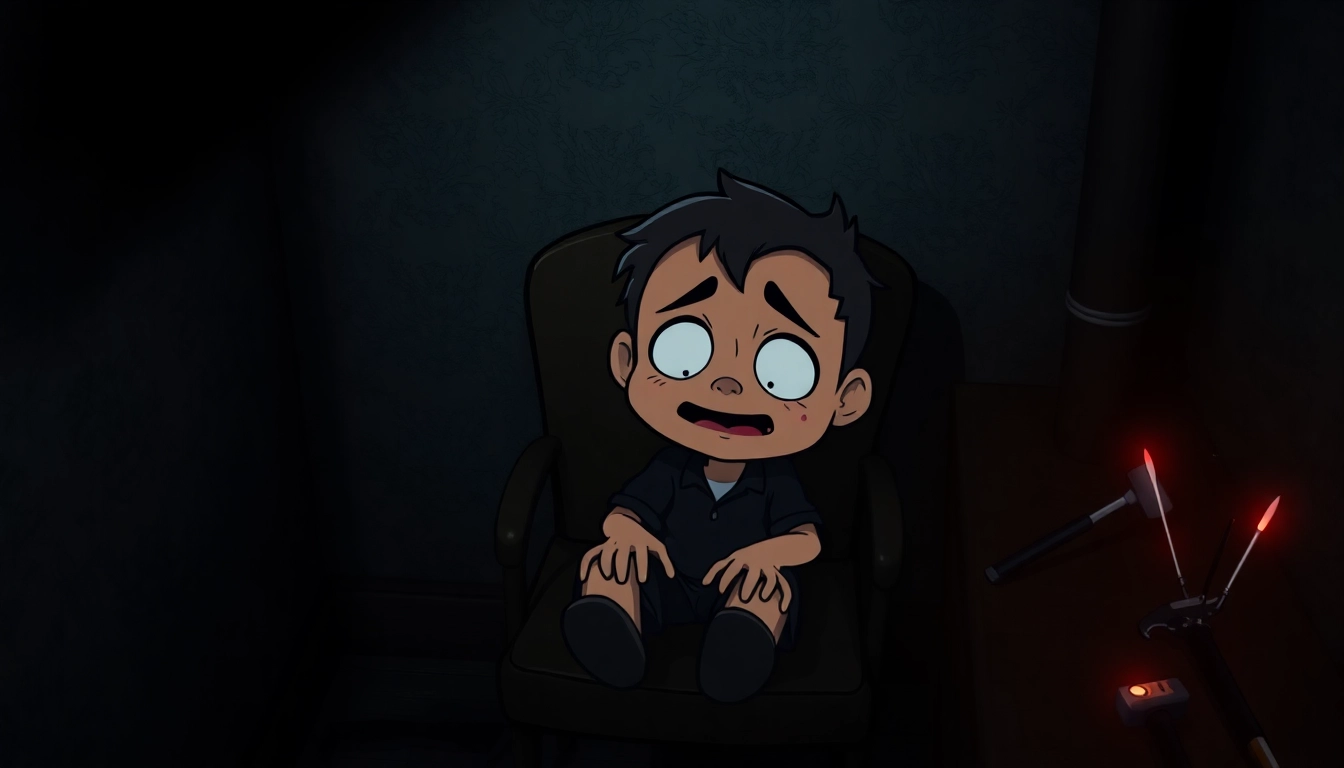Overview and Context of BLOODMONEY: DARK CLICKER DESCENT
In the realm of psychological horror and morally challenging gaming experiences, bloddmoney game stands out as a disturbing yet compelling journey into human morality and desperation. This dark clicker game immerses players in a grim narrative where every click not only generates vital funds but also incrementally erodes the moral fabric of the protagonist, Harvey. Set against a backdrop of life-threatening urgency, BLOODMONEY pushes players to confront the uncomfortable question: How far are you willing to go when your survival depends on it? The game’s mechanics, narrative depth, and emotional impact make it a unique addition to the psychological horror genre, challenging players’ perceptions of right and wrong in a visceral, unsettling way.
The Core Mechanics of BLOODMONEY
Clicking for Profit and Its Consequences
At the heart of BLOODMONEY lies a deceptively simple mechanic: clicking on Harvey to generate money. Initially, each click is innocuous, offering a sense of control and immediate reward. However, as the game progresses, each click begins to cause Harvey pain, with visual cues and dialogue subtly revealing his suffering. This creates a compelling tension—players must decide whether to click for maximum profit or to exercise restraint to minimize Harvey’s torment. The game’s core mechanic is a metaphor for real-world dilemmas about sacrifice, morality, and the cost of survival.
Upgrade System and Progressive Violence
As players accumulate funds, they gain access to a shop offering increasingly disturbing tools—needles, hammers, knives—that amplify profits but deepen Harvey’s suffering. These upgrades introduce a twisted risk-reward dynamic: the more violent tools, the faster the goal is reached, but at a significant moral and visual cost. Visual effects intensify with each upgrade, with Harvey’s appearance and reactions becoming progressively more distressed and altered, accentuating the psychological horror. This system invites players to reflect on their choices—how much suffering are they willing to endorse for monetary gain?
The Dark Narrative of BLOODMONEY and Its Characters
Harvey: The Innocent Catalyst
Harvey is portrayed as a cheerful, naive character initially unaware of the full extent of his suffering. His genuine surprise at the more violent tools, such as the hammer, reveals that he might not fully comprehend what is happening to him, adding a layer of moral ambiguity. Harvey symbolizes innocence and the human desire to help, even when caught in a horrifying situation. As the game unfolds, Harvey’s reactions shift from cheerful to terrified, embodying the emotional toll of the player’s decisions. His visual and vocal cues serve as a mirror to the moral choices made, making the suffering palpable and emotionally impactful.
The Shop: A Symbol of Dark Forces
The shop acts as a facilitator for the moral descent, offering tools that range from seemingly harmless to outright violent. What is particularly unsettling is that Harvey appears genuinely surprised by the more violent weapons, suggesting he might not fully understand what he is endorsing. This raises questions about the game’s underlying themes—whether Harvey is a willing participant or a puppet controlled by darker influences. The shop’s role as a conduit for escalating violence underscores the game’s commentary on human nature and the corrupting influence of desperation.
Multiple Pathways and Endings: Moral Outcomes and Their Significance
The Three Endings Explored
BLOODMONEY features three distinct endings, each reflecting different moral choices and their consequences:
- The Good Ending: Achieved by minimizing Harvey’s suffering—using less violent tools like scissors and avoiding the more gruesome upgrades. This path emphasizes compassion and restraint, highlighting that survival doesn’t have to come at a moral cost.
- The Normal Ending: An intermediate route where players use a mix of tools, including some violence, but attempt to balance profit with morality. The ending reflects a compromise, showcasing the gray areas of moral decision-making.
- The Bad Ending: Reached when players opt for maximum efficiency regardless of human suffering—using violent tools like the hammer or knife without restraint. This route results in Harvey’s ultimate torment and a bleak, nihilistic conclusion, emphasizing the destructive potential of greed and moral abandonment.
The game subtly tracks player choices, and multiple playthroughs reveal how nuanced decisions can lead to different outcomes, emphasizing that morality in desperate circumstances is complex and multifaceted.
Community Insights and Player Experiences
Shared Stories and Interpretations
Players around the world have engaged deeply with BLOODMONEY, sharing insights, theories, and emotional reactions. Many note how Harvey’s reactions—his surprise, fear, and pain—are remarkably realistic, heightening the emotional stakes. Some players emphasize their internal struggle when choosing violent upgrades, recognizing the game’s success in evoking empathy and guilt. Reddit forums and YouTube comment sections are filled with discussions about the moral implications of the choices, with many reflecting on how the game mirrors real-world dilemmas about sacrificing morality for survival.
Furthermore, community members have discovered subtle details—like Harvey’s genuine surprise at violent tools—adding layers to the moral debate. These insights deepen appreciation for the game’s storytelling and emotional design, illustrating how even small choices ripple into significant consequences.
Exploring Deeper Themes: Morality, Desperation, and Human Nature
Morality in the Face of Life and Death
BLOODMONEY is more than a horror game; it’s a philosophical exploration of morality under extreme conditions. The game forces players to confront their own values—are they willing to compromise their ethics when faced with imminent death? The varying endings serve as a mirror to real-world questions about what sacrifices are acceptable when survival is at stake. It challenges the notion that morality is absolute, instead suggesting it is fluid and context-dependent.
Desperation as a Catalyst for Moral Decay
The narrative underscores how desperation can erode moral boundaries, leading individuals to make choices they might otherwise reject. Harvey’s situation epitomizes this, as his cheerful demeanor fades into terror and suffering. The game poignantly illustrates that beneath the veneer of civility lies a potential for moral darkness, especially when survival is threatened. This reflection resonates with real-world scenarios where individuals or societies face ethical compromises in times of crisis.
Human Nature and the Duality of Good and Evil
One of BLOODMONEY’s most compelling themes is its examination of human duality. Harvey symbolizes innocence, trying to help, while the shop represents darker forces—possibly external entities or the player’s own moral shadow. The game becomes a testing ground: are we inherently good, or do circumstances reveal our darker nature? Multiple playthroughs reveal that even players aiming for the good ending are tempted by the ease of violence, highlighting the constant struggle within all of us.
Comparisons with Other Psychological Horror Games
While BLOODMONEY shares thematic similarities with titles like *The Cat Lady* or *Silent Hill*, its unique mechanic of moral decision-making through clicking sets it apart. Unlike traditional horror games that rely on jump scares or external threats, BLOODMONEY’s horror is internal—manifested through guilt, moral conflict, and emotional distress. Its minimalist gameplay, combined with rich narrative layers, echoes the psychological depth found in games like *Lobotomy Corporation* or *Darkwood*, but with a singular focus on moral choices and their consequences.
Final Reflections: When Survival Comes at What Moral Cost?
Ultimately, BLOODMONEY challenges players to reflect on the true meaning of morality in desperate times. The game’s title encapsulates its core message: that money—and by extension, survival—can come at a grave moral price. The emotional weight of Harvey’s suffering, coupled with the subtle visual and narrative cues, creates a haunting experience that lingers long after gameplay ends.
As you reach the culmination of your choices, the three endings serve as a stark reminder: the path you choose defines not only Harvey’s fate but also your own moral compass. Will you take the path of minimal harm, or will you sacrifice your ethics for the sake of survival? The game asks—and perhaps forces—players to confront their own thresholds for moral compromise.
Discover more about this disturbing journey and how it reflects our own human nature by exploring bloodmoney game. When survival is on the line, the question remains—how far are you willing to go?







